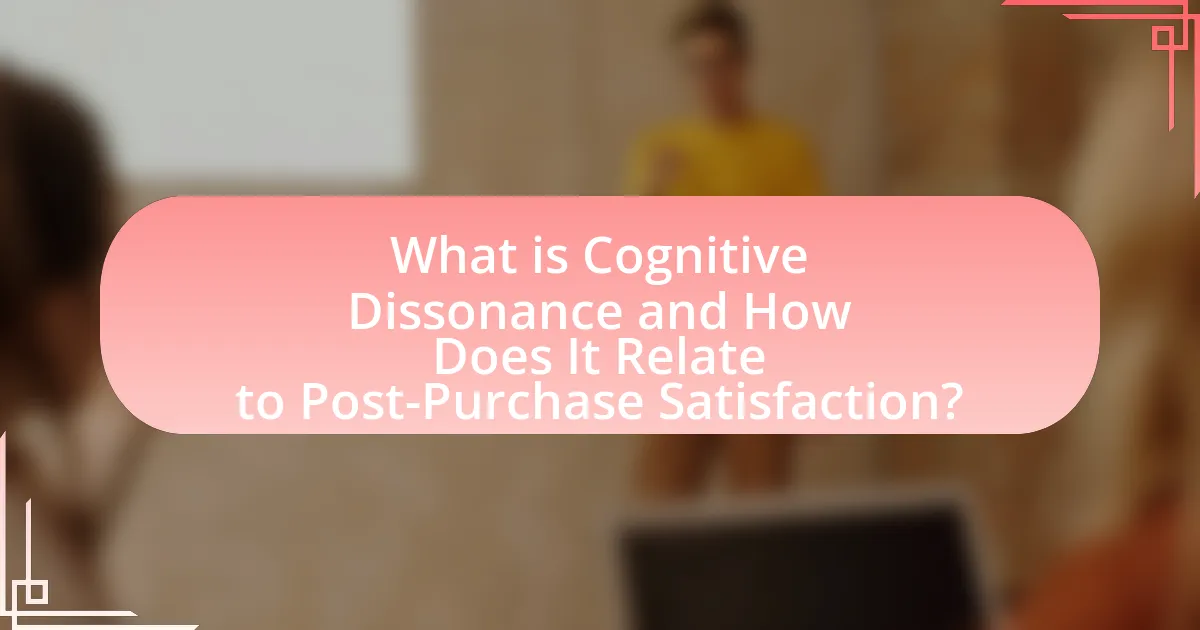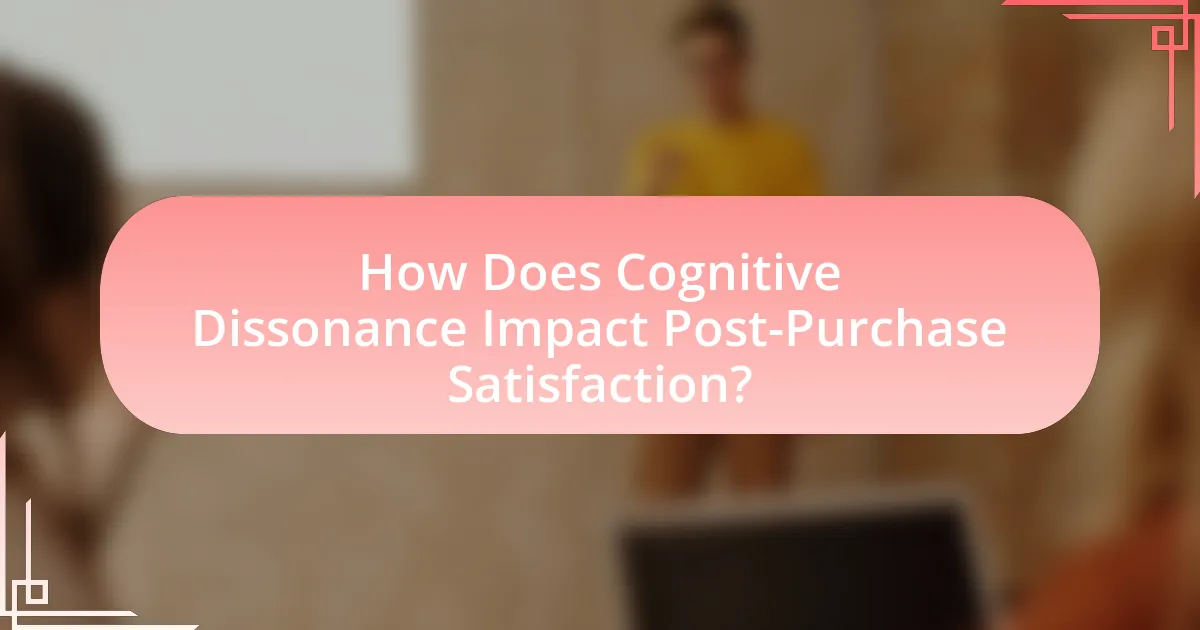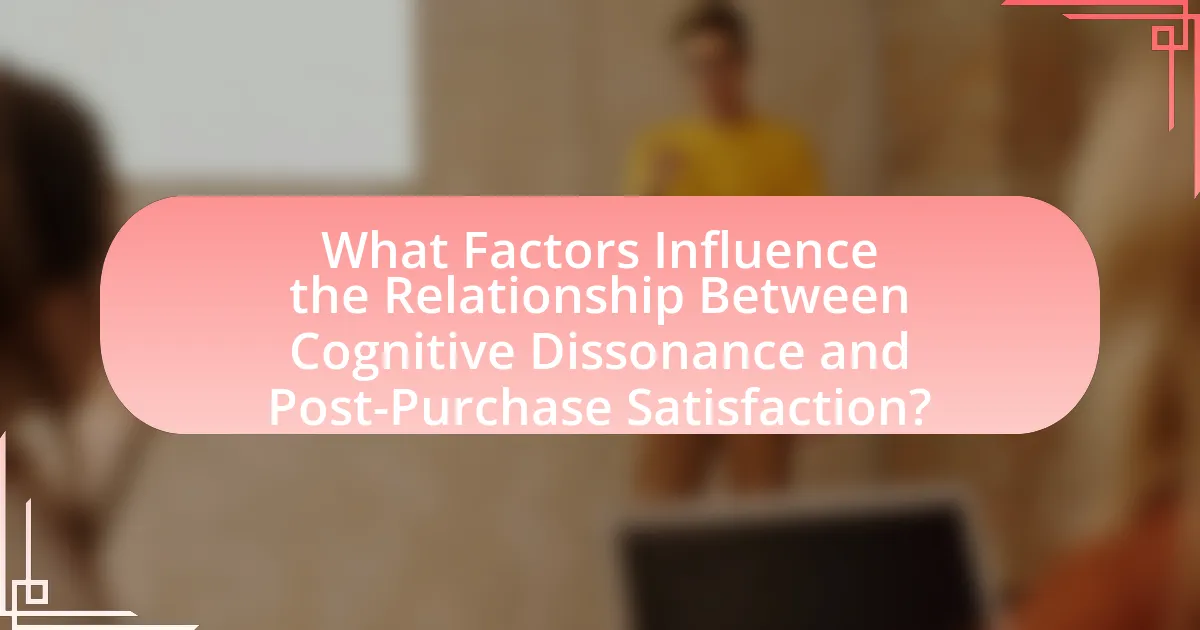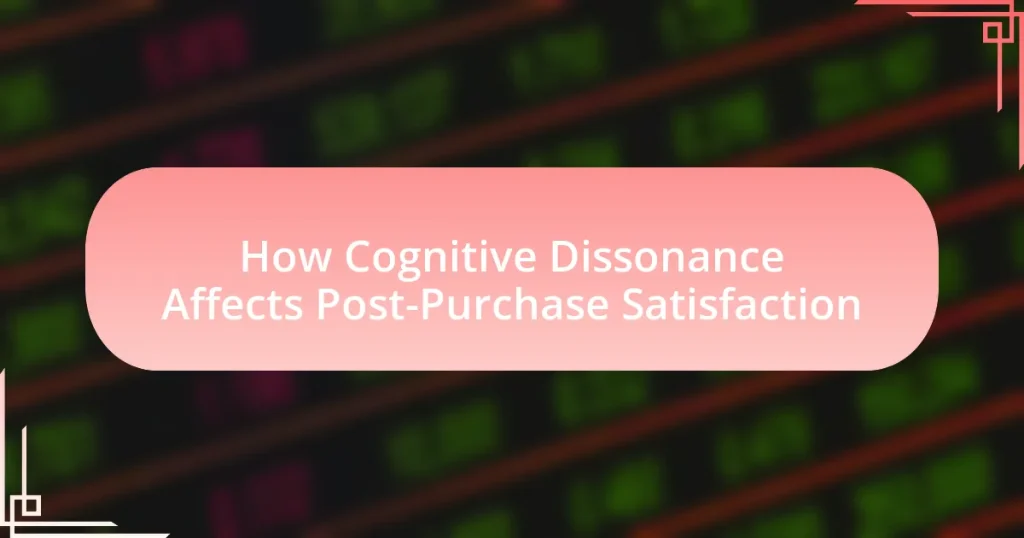Cognitive dissonance is a psychological phenomenon that occurs when individuals experience conflicting beliefs or attitudes, particularly after making a purchase. This article explores how cognitive dissonance impacts post-purchase satisfaction, highlighting its manifestations, contributing psychological factors, and emotional responses. It discusses the significance of post-purchase satisfaction for consumer loyalty and future purchasing decisions, as well as strategies for consumers and businesses to mitigate dissonance and enhance satisfaction. Key insights include the role of marketing in shaping consumer expectations and the effectiveness of coping strategies in reducing cognitive dissonance.

What is Cognitive Dissonance and How Does It Relate to Post-Purchase Satisfaction?
Cognitive dissonance is a psychological phenomenon that occurs when an individual experiences conflicting beliefs or attitudes, particularly after making a decision. This dissonance can lead to feelings of discomfort or anxiety, especially in the context of post-purchase satisfaction, where a consumer may question their choice after acquiring a product. Research indicates that when consumers experience cognitive dissonance following a purchase, they may seek to alleviate this discomfort by rationalizing their decision, which can enhance their overall satisfaction with the purchase. For instance, a study by Festinger (1957) demonstrated that individuals often change their beliefs to align with their actions, thereby reducing dissonance and increasing satisfaction. Thus, cognitive dissonance plays a critical role in shaping post-purchase satisfaction by influencing how consumers perceive and justify their buying decisions.
How does cognitive dissonance manifest after a purchase?
Cognitive dissonance manifests after a purchase as a psychological discomfort experienced by consumers when their beliefs or values conflict with their buying decisions. This discomfort often leads to second-guessing the purchase, where individuals may question whether they made the right choice, especially if they encounter negative information about the product or if they see alternatives that seem better. Research indicates that approximately 60-70% of consumers experience cognitive dissonance after making significant purchases, particularly in high-involvement categories like cars or electronics. This phenomenon can result in behaviors aimed at reducing dissonance, such as seeking positive reviews or justifying the purchase to themselves and others.
What psychological factors contribute to cognitive dissonance in consumers?
Psychological factors contributing to cognitive dissonance in consumers include the need for consistency, the importance of self-image, and the influence of social norms. The need for consistency drives consumers to align their beliefs and behaviors; when a purchase contradicts their values or expectations, dissonance arises. Additionally, consumers often seek to maintain a positive self-image, leading to discomfort when their choices conflict with their self-perception. Social norms also play a role, as consumers may experience dissonance when their purchases do not conform to the expectations of their peers or society. Research by Festinger (1957) established the theory of cognitive dissonance, demonstrating that individuals strive to reduce dissonance through rationalization or changing their beliefs, which further validates these psychological factors.
How do consumers recognize cognitive dissonance post-purchase?
Consumers recognize cognitive dissonance post-purchase through feelings of regret or discomfort regarding their decision. This recognition often occurs when they encounter information that contradicts their choice, such as negative reviews or better alternatives. Research indicates that 60% of consumers experience post-purchase dissonance, particularly when the purchase is significant or involves high stakes. This discomfort prompts them to seek reassurance, often leading to behaviors like seeking positive feedback about their choice or rationalizing their decision to alleviate the dissonance.
Why is post-purchase satisfaction important for consumers?
Post-purchase satisfaction is crucial for consumers because it influences their future buying decisions and brand loyalty. When consumers feel satisfied after a purchase, they are more likely to repeat their purchases and recommend the product or brand to others, which can lead to increased sales and positive word-of-mouth. Research indicates that satisfied customers are 60-70% more likely to repurchase from the same brand, highlighting the direct correlation between satisfaction and consumer behavior. Additionally, high levels of post-purchase satisfaction can mitigate feelings of cognitive dissonance, where consumers may question their purchase decisions, thereby reinforcing their confidence in their choices and enhancing overall consumer experience.
What role does post-purchase satisfaction play in consumer loyalty?
Post-purchase satisfaction is crucial for fostering consumer loyalty, as it directly influences a customer’s likelihood to repurchase and recommend a brand. When consumers feel satisfied after a purchase, they are more inclined to develop a positive emotional connection with the brand, which enhances their loyalty. Research indicates that satisfied customers are 60-70% more likely to repurchase compared to dissatisfied ones, demonstrating the strong correlation between satisfaction and repeat business. Additionally, satisfied customers often engage in positive word-of-mouth, further solidifying their loyalty and attracting new customers.
How does post-purchase satisfaction influence future purchasing decisions?
Post-purchase satisfaction significantly influences future purchasing decisions by shaping consumer loyalty and repeat buying behavior. When customers feel satisfied with their purchase, they are more likely to return to the same brand or retailer for future transactions, as evidenced by a study from the Journal of Marketing Research, which found that satisfied customers are 60-70% more likely to repurchase. This satisfaction reduces cognitive dissonance, reinforcing positive perceptions of the brand and increasing the likelihood of recommending it to others. Conversely, dissatisfaction can lead to negative word-of-mouth and a decrease in future purchases, highlighting the critical role of post-purchase satisfaction in consumer decision-making.

How Does Cognitive Dissonance Impact Post-Purchase Satisfaction?
Cognitive dissonance negatively impacts post-purchase satisfaction by creating feelings of regret or doubt about the purchase decision. When consumers experience cognitive dissonance, they may question whether they made the right choice, leading to dissatisfaction with the product or service. Research indicates that approximately 60-70% of consumers report experiencing cognitive dissonance after making significant purchases, which can result in a decrease in overall satisfaction and an increased likelihood of returning the product. This phenomenon highlights the importance of addressing consumer concerns and reinforcing positive aspects of the purchase to mitigate dissonance and enhance satisfaction.
What are the effects of cognitive dissonance on consumer emotions?
Cognitive dissonance negatively affects consumer emotions by creating feelings of discomfort and anxiety following a purchase. When consumers experience cognitive dissonance, they may question their decision, leading to regret or dissatisfaction with the product. Research indicates that approximately 60-70% of consumers experience post-purchase dissonance, which can manifest as buyer’s remorse, impacting their overall satisfaction and future purchasing behavior. This emotional turmoil often prompts consumers to seek reassurance or justification for their choices, further influencing their emotional state and perception of the brand.
How can cognitive dissonance lead to regret or satisfaction?
Cognitive dissonance can lead to regret or satisfaction based on the alignment between a person’s beliefs and their actions. When individuals experience cognitive dissonance after a purchase, they may feel regret if their decision conflicts with their pre-existing beliefs about value or quality. For example, if someone buys an expensive item but later finds a cheaper alternative that performs better, the dissonance between their belief in making a wise financial decision and their actual purchase can result in regret.
Conversely, cognitive dissonance can lead to satisfaction when individuals reconcile their beliefs with their actions. If a person purchases a product and later reinforces their decision by focusing on its positive attributes, they may experience satisfaction. This is often seen in scenarios where consumers justify their choices by emphasizing the benefits of their purchase, thereby reducing dissonance and enhancing their overall contentment with the decision.
What emotional responses are common in consumers experiencing cognitive dissonance?
Consumers experiencing cognitive dissonance commonly exhibit emotional responses such as anxiety, regret, and discomfort. These emotions arise when there is a conflict between their beliefs and behaviors, particularly after making a purchase that contradicts their expectations or values. Research indicates that 63% of consumers report feeling regret after a purchase, highlighting the prevalence of this emotional response in situations of cognitive dissonance. Additionally, anxiety can manifest as consumers question their decisions and seek reassurance, further illustrating the psychological impact of conflicting thoughts and feelings.
How do consumers cope with cognitive dissonance after a purchase?
Consumers cope with cognitive dissonance after a purchase primarily through rationalization, seeking reassurance, and altering their perceptions. Rationalization involves justifying the purchase by emphasizing its benefits or downplaying its drawbacks, which helps alleviate feelings of regret. Seeking reassurance often includes looking for positive reviews or feedback from others who have made similar purchases, reinforcing the decision. Additionally, consumers may alter their perceptions by focusing on the positive aspects of the product while ignoring negative information, a behavior supported by research indicating that individuals tend to seek information that confirms their choices (Festinger, 1957). This combination of strategies effectively reduces the discomfort associated with cognitive dissonance, leading to greater post-purchase satisfaction.
What strategies do consumers use to reduce cognitive dissonance?
Consumers use several strategies to reduce cognitive dissonance, including seeking reassurance, changing beliefs, and minimizing the importance of the decision. Seeking reassurance involves looking for positive feedback from others about their purchase, which helps affirm their choice. Changing beliefs can occur when consumers alter their perceptions about the product or service to align with their decision, such as emphasizing its benefits while downplaying any negatives. Minimizing the importance of the decision involves convincing themselves that the purchase is not significant, thereby reducing the emotional impact of any conflicting thoughts. These strategies are supported by research indicating that consumers actively engage in cognitive processes to alleviate discomfort associated with dissonance, ultimately enhancing their post-purchase satisfaction.
How effective are these coping strategies in enhancing post-purchase satisfaction?
Coping strategies are highly effective in enhancing post-purchase satisfaction by addressing cognitive dissonance. These strategies, such as seeking reassurance, re-evaluating the purchase, and focusing on positive aspects, help consumers mitigate feelings of regret or doubt after a purchase. Research indicates that when consumers actively engage in these coping mechanisms, they report higher levels of satisfaction and reduced dissonance. For instance, a study published in the Journal of Consumer Research found that consumers who employed positive reframing techniques experienced a significant increase in post-purchase satisfaction compared to those who did not utilize such strategies. This demonstrates that effective coping strategies can lead to a more favorable evaluation of the purchase experience, ultimately enhancing overall satisfaction.

What Factors Influence the Relationship Between Cognitive Dissonance and Post-Purchase Satisfaction?
Cognitive dissonance significantly influences post-purchase satisfaction through factors such as the level of commitment to the purchase, the perceived value of the product, and the availability of alternative options. High commitment to a purchase often leads to greater dissonance when expectations are not met, which can diminish satisfaction. Conversely, when consumers perceive high value in their purchase, they are more likely to reconcile any dissonance, resulting in higher satisfaction levels. Additionally, the presence of attractive alternatives can exacerbate dissonance, as consumers may question their decision, negatively impacting their overall satisfaction. Research by Festinger (1957) on cognitive dissonance supports these assertions, indicating that individuals strive for internal consistency, which directly affects their satisfaction with decisions made.
How do product type and consumer expectations affect cognitive dissonance?
Product type and consumer expectations significantly influence cognitive dissonance by determining the alignment between anticipated and actual product performance. When consumers purchase high-involvement products, such as electronics or luxury items, their expectations are typically elevated, leading to a greater potential for dissonance if the product fails to meet those expectations. Conversely, low-involvement products, like everyday groceries, tend to generate less dissonance due to lower consumer expectations. Research indicates that cognitive dissonance arises when there is a discrepancy between beliefs and behaviors, particularly in high-stakes purchases, where consumers may experience regret or dissatisfaction if the product does not fulfill their anticipated value. This relationship underscores the importance of managing consumer expectations through marketing and product quality to minimize dissonance and enhance post-purchase satisfaction.
What types of products are more likely to induce cognitive dissonance?
Products that are more likely to induce cognitive dissonance include high-involvement items, such as expensive electronics, luxury goods, and significant lifestyle choices. These products often require substantial financial investment and personal commitment, leading consumers to experience conflicting feelings if their expectations are not met. For instance, a study published in the Journal of Consumer Research found that consumers who purchased high-cost items reported higher levels of dissonance when faced with negative reviews or buyer’s remorse, as the stakes of their decision were greater. This indicates that the more significant the investment in a product, the more likely cognitive dissonance will occur if the outcome does not align with the consumer’s beliefs or expectations.
How do consumer expectations shape their post-purchase experience?
Consumer expectations significantly shape their post-purchase experience by influencing their satisfaction levels and perceptions of value. When consumers have high expectations prior to a purchase, they are more likely to feel disappointed if the product or service does not meet those expectations, leading to cognitive dissonance. Research indicates that 70% of consumers report feeling regret after a purchase when their expectations are not fulfilled, which can negatively impact their overall satisfaction and likelihood of repeat purchases. Conversely, when expectations are met or exceeded, consumers experience higher satisfaction, reinforcing positive feelings about the brand and increasing loyalty. Thus, managing consumer expectations is crucial for enhancing post-purchase experiences and minimizing cognitive dissonance.
What role does marketing play in shaping cognitive dissonance?
Marketing plays a significant role in shaping cognitive dissonance by influencing consumer perceptions and expectations before and after a purchase. Through targeted messaging, advertisements, and branding strategies, marketing creates a narrative that consumers internalize, which can lead to conflicting beliefs when the actual product experience does not align with those expectations. For instance, if a brand promotes a product as the best in its category, but the consumer finds it underwhelming, this discrepancy generates cognitive dissonance. Research indicates that consumers often seek to resolve this dissonance by either justifying their purchase or altering their beliefs about the product, demonstrating how marketing directly impacts their post-purchase satisfaction.
How can marketing strategies mitigate cognitive dissonance?
Marketing strategies can mitigate cognitive dissonance by reinforcing the buyer’s decision through targeted communication and reassurance. For instance, post-purchase follow-up emails that highlight the benefits of the product and customer testimonials can help alleviate doubts. Research indicates that providing customers with positive reinforcement, such as satisfaction guarantees or loyalty rewards, can further reduce feelings of regret or uncertainty after a purchase. A study published in the Journal of Consumer Research found that when consumers receive affirming messages about their choices, their overall satisfaction increases, thereby decreasing cognitive dissonance.
What messaging can enhance post-purchase satisfaction?
Effective messaging that enhances post-purchase satisfaction includes personalized follow-up communications, reassurance of the purchase decision, and highlighting the benefits of the product. Personalized follow-ups, such as thank-you emails or satisfaction surveys, create a connection with the customer and reinforce their choice. Reassurance messaging, which can include testimonials or usage tips, helps alleviate any cognitive dissonance by confirming that the purchase was a good decision. Highlighting benefits, such as how the product meets the customer’s needs or improves their life, further solidifies satisfaction. Research indicates that customers who receive personalized communication are 60% more likely to feel satisfied with their purchase, demonstrating the effectiveness of tailored messaging in reducing cognitive dissonance and enhancing overall satisfaction.
What are practical strategies for enhancing post-purchase satisfaction amidst cognitive dissonance?
Practical strategies for enhancing post-purchase satisfaction amidst cognitive dissonance include providing clear product information, offering reassurance through follow-up communication, and facilitating easy returns. Clear product information helps consumers align their expectations with reality, reducing dissonance. Follow-up communication, such as personalized emails or satisfaction surveys, reinforces the value of the purchase and addresses any concerns, thereby enhancing satisfaction. Additionally, an easy return policy allows consumers to feel secure in their decision, mitigating feelings of regret and promoting a positive post-purchase experience. Research indicates that these strategies can significantly lower cognitive dissonance and improve overall customer satisfaction.
How can consumers make informed decisions to minimize cognitive dissonance?
Consumers can minimize cognitive dissonance by conducting thorough research before making a purchase. This involves gathering information about products, comparing alternatives, and understanding the implications of their choices. Studies indicate that informed consumers are less likely to experience regret or doubt after a purchase, as they have a clearer understanding of their options and the value of their decisions. For instance, a study published in the Journal of Consumer Research found that consumers who engage in pre-purchase information seeking report higher satisfaction levels and lower dissonance post-purchase. By actively seeking information and reflecting on their needs and preferences, consumers can make choices that align with their values, thereby reducing the likelihood of cognitive dissonance.
What best practices can businesses implement to support customer satisfaction post-purchase?
Businesses can implement several best practices to support customer satisfaction post-purchase, including proactive communication, personalized follow-ups, and effective handling of returns. Proactive communication involves sending confirmation emails and updates about the order status, which reassures customers and reduces anxiety. Personalized follow-ups, such as thank-you messages or surveys, enhance the customer experience by making them feel valued and heard. Effective handling of returns, including a clear and hassle-free return policy, can significantly mitigate cognitive dissonance by reassuring customers that they can change their minds without penalty. Research indicates that 70% of customers are more likely to return to a business that offers a simple return process, highlighting the importance of these practices in fostering customer loyalty and satisfaction.


